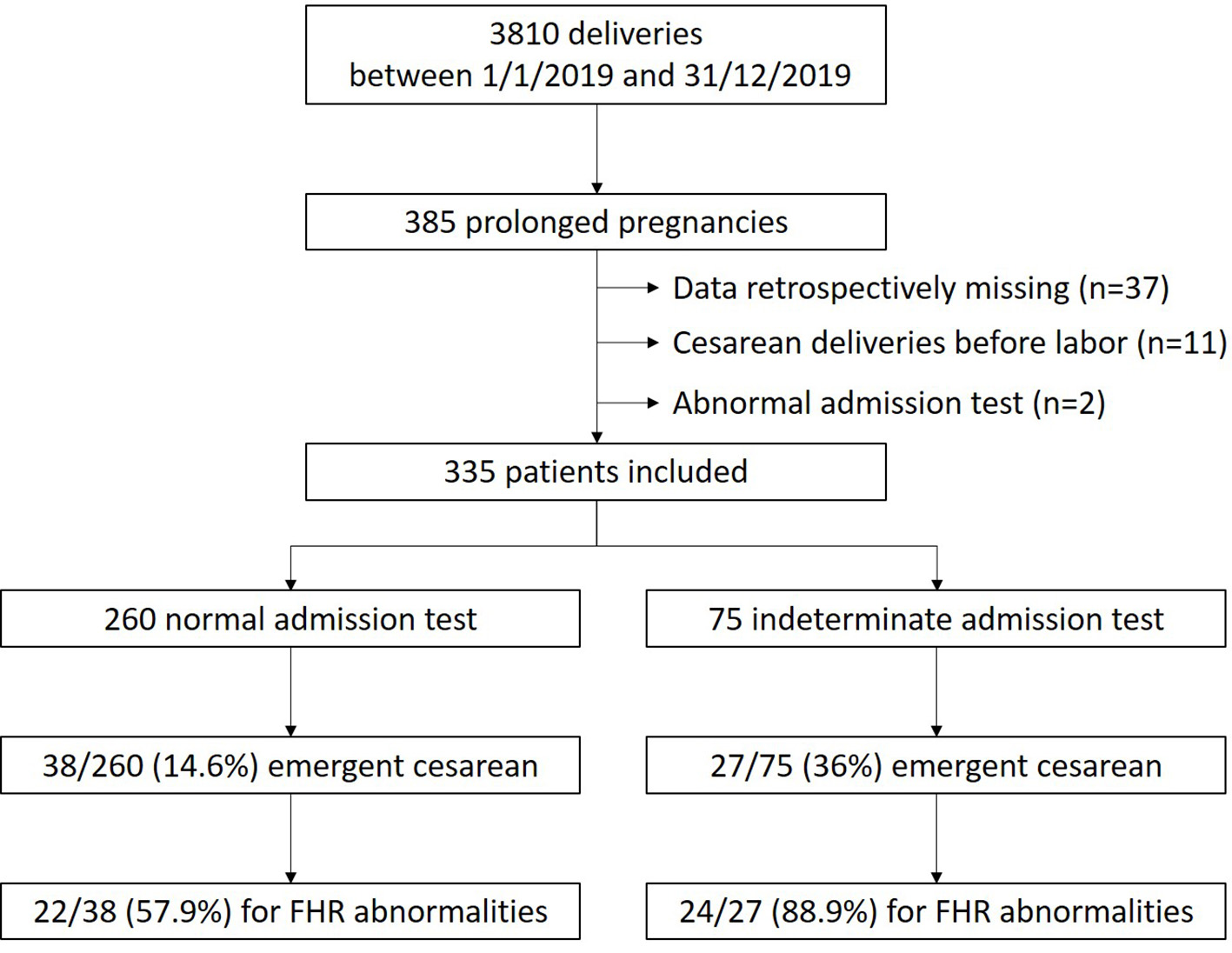
Figure 1. Study flow chart.
| Journal of Clinical Gynecology and Obstetrics, ISSN 1927-1271 print, 1927-128X online, Open Access |
| Article copyright, the authors; Journal compilation copyright, J Clin Gynecol Obstet and Elmer Press Inc |
| Journal website https://www.jcgo.org |
Original Article
Volume 11, Number 1, March 2022, pages 9-13
Is the Admission Cardiotocography Test Predictive of an Emergent Cesarean Delivery During Labor in Prolonged Pregnancies?
Figure

Tables
| Entire cohort (N = 335) | Normal FHR (category 1)a (N = 260) | Indeterminate FHR (category 2)a (N = 75) | P-valueb | |
|---|---|---|---|---|
| aAccording to the American College of Obstetrics and Gynecology classification. bComparison between “normal” and “indeterminate” FHR during admission cardiotocography test. FHR: fetal heart rate. | ||||
| Maternal age (years) | 30 (16 - 46) | 30 (16 - 46) | 29 (20 - 45) | 0.14 |
| Body mass index (kg/cm2) | 28 (18 - 46) | 28 (18 - 46) | 28 (19 - 44) | 1 |
| Parity | 1 (0 - 6) | 1 (0 - 6) | 0 (0 - 4) | 0.31 |
| History of scarred uterus (%) | 33 (9.9) | 24 (9.2) | 9 (12) | 0.48 |
| Gestational age at delivery (weeks) | 41.2 (41.0 - 41.9) | 41.2 (41.0 - 41.9) | 41.2 (41.0 - 41.7) | 0.18 |
| Labor induction (%) | 157 (46.9) | 120 (46.2) | 37 (49.3) | 0.63 |
| Spontaneous rupture of the membranes before onset of labor (%) | 58 (17.3) | 43 (16.5) | 15 (20) | 0.48 |
| Oligoamnios (%) | 10 (3.0) | 6 (2.3) | 4 (5.3) | 0.17 |
| Baby weight (g) | 3,510 (2,060 - 4,640) | 3,510 (2,060 - 4,640) | 3,500 (2,500 - 4,300) | 0.44 |
| Entire cohort (N = 335) | Normal FHR (category 1)a (N = 260) | Indeterminate FHR (category 2)a (N = 75) | P-valueb | |
|---|---|---|---|---|
| aAccording to the American College of Obstetrics and Gynecology classification. bComparison between “normal category 1” and “indeterminate category 2” FHR during the admission cardiotocography test. FHR: fetal heart rate. | ||||
| Cesarean delivery (%) | 65 (19.4) | 38 (14.6) | 27 (36) | < 0.01 |
| Cesarean delivery for fetal distress (%) | 46/65 (76.7) | 22/38 (57.9) | 24/27 (88.9) | 0.02 |
| Operative vaginal delivery (%) | 74 (22.1) | 55 (21.1) | 19 (25.3) | 0.44 |
| Neonatal pH | 7.23 (6.99 - 7.42) | 7.23 (7.02 - 7.42) | 7.23 (6.99 - 7.41) | 0.95 |
| Neonatal lactates (mmol/L) | 4.5 (1.5 - 12) | 4.25 (1.5 - 12) | 4.25 (2.0 - 9.0) | 0.82 |
| Apgar score (5 minutes) | 10 (1 - 10) | 10 (4 - 10) | 10 (1 - 10) | 0.21 |
| Apgar score (5 min) < 7 (%) | 4 (1.2) | 2 (0.7) | 2 (2.7) | 0.17 |
| Hospitalization in neonatal intensive care unit (%) | 3 (0.9) | 2 (0.8) | 1 (1.3) | 0.53 |
| Odds ratio | 95% confidence interval | P-value | |
|---|---|---|---|
| aAccording to the American College of Obstetrics and Gynecology classification. FHR: fetal heart rate. | |||
| Parity | 0.46 | 0.3 - 0.7 | < 0.01 |
| Gestational age at delivery | 2.35 | 0.6 - 8.8 | 0.20 |
| Labor induction | 1.68 | 0.9 - 3.1 | 0.09 |
| Scarred uterus | 9.08 | 3.6 - 23.2 | < 0.01 |
| Category 2 FHR patterna | 3.47 | 1.8 - 6.5 | < 0.01 |